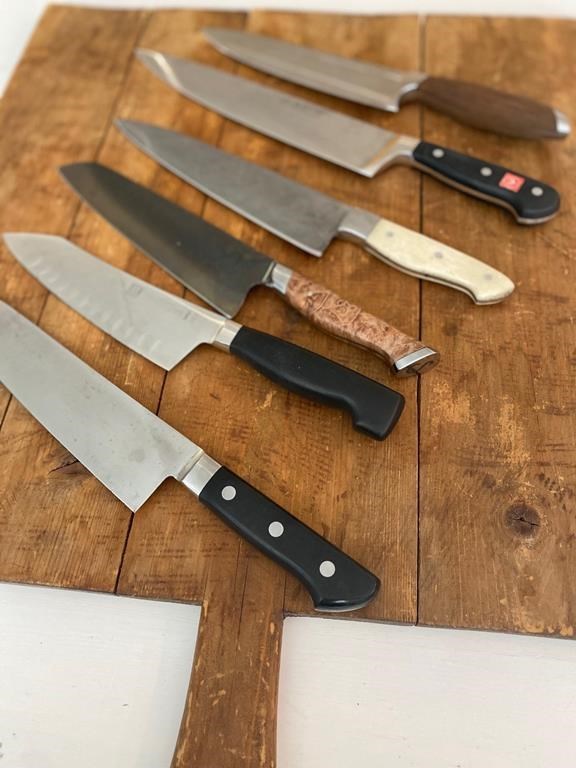THE ASSOCIATED PRESS — There is likely no kitchen tool purchase as important as your cooking knives. And it's easy to feel overwhelmed by the variety of styles, prices, sizes and materials.
But while the category of knives is one you may want to explore for the rest of your cooking days, picking a couple of all-purpose kitchen knives can be simple.
Many professionals will tell you that you can perform virtually any kitchen task skillfully with either a chef’s knife or a paring knife, and that while adding other knives to your arsenal is appealing and can be useful, it’s not strictly necessary.
Unless, maybe, it's a serrated knife, something every cook really should have too.
Serrated knives are primarily used for slicing bread; the serrated edge allows you to saw back and forth without compressing the loaf. It can also be used for other foods, like tomatoes.
When buying knives, go for individual ones you like rather than a boxed set, which might leave you with ones you don’t enjoy using.
PARING KNIFE
Simply a small knife for tasks requiring more dexterity and precision than a larger knife provides.
The blade is usually about 3 inches long. Use a paring knife to peel fruits and vegetables, say, or devein shrimp. I think a straight rather than curved blade makes slicing tasks easier.
CHEF'S KNIFE
Buying one requires a bit more thought. Most chef’s knives are either 8 or 10 inches long, from the bolster (where the blade meets the handle) to the tip of the blade. Many professional chefs like a longer, 10-inch knife, but as with everything regarding knives, it’s about your own preference and comfort level. If you are more comfortable handling a shorter, 8-inch knife, then that’s the size you should go for. The longer the blade, the more you can chop at one time.
Use your chef’s knife for most kitchen work, from chopping onions and garlic to slicing carrots to slicing a roast to deboning a chicken.
Again, if you are a knife fan and want to lay in a supply of 4-, 6-, 8- and 10-inch knives, then you can choose the optimal knife for any task. But know that with one good chef’s knife, plus your paring knife and a serrated knife, you really don’t need anything else.
WHAT TO LOOK FOR
When buying a knife, especially one you're going to spend some real cash on, you absolutely need to hold it in your hand. Pretend you are using it, and literally make slicing motions to test how it feels in your hand. It should have some heft.
Make sure there are no cracks near the rivets or handle, anywhere that could feel rough and allow residue to collect.
There are three main types of metal used to make knives: carbon steel, stainless steel and high-carbon stainless steel. Carbon steel is generally the hardest, stainless steel the softest. The harder the metal, the easier it is to keep sharp. However, harder metal also requires more care.
Carbon steel rusts easily, so those knives have to be consistently washed and dried to avoid discoloration. Many professional chefs find this a fine tradeoff, but home cooks might prefer something requiring less maintenance.
Many good-quality commercial knives designed for home cooks are high-carbon stainless steel, which is easier to care for than straight carbon steel, and keeps a sharp edge longer than stainless.
VARIATIONS
Chef’s knives are often divided into two main types: Japanese and German, or Western-style. Japanese knives are usually thinner and sharper, many made of higher-maintenance carbon steel. German-style knives are more durable, though they might not get as sharp. Japanese knives are often hand-honed, and have a straighter blade for more precise slicing. Both are great options.
If you want to delve deeper, you can find Swedish steel knives, French steel knives and more, plus lots of knives made in the U.S.A. Some companies making high-quality kitchen knives in the U.S. are Steelport, Schmidt Brothers and Faneema Cutlery.
The blade of a chef’s knife is both long and wide. Different types have different curvatures on the bottom of the blade, from straight to gently curved. Many American and German knives have a pronounced curve, while French and Japanese knives tend to have straighter blades. A Santoku knife is a Japanese chef’s knife with small indentations along the straight blade, in the style of a Chinese slicing cleaver.
Ceramic knives are also popular. These are made from hardy ceramics, but are still fairly fragile (don’t drop one!). They hold a sharp edge pretty well, but their lightness isn’t as satisfying to use for most real kitchen chopping.
It is good practice to wash, dry and store knives immediately after using them. This will help them stay sharp and in the best condition overall (and prevent accidents!). Never put cooking knives in a dishwasher, as it can dull the blade.
Whatever knife you choose, buy a honing rod, sharpening steel or whetstone. Learn how to use it properly to keep your knives sharp, and see how much it ups your chopping game.
—- Katie Workman writes regularly about food for The Associated Press. She has written two cookbooks focused on family-friendly cooking, “Dinner Solved!” and “The Mom 100 Cookbook.” She blogs at . She can be reached at [email protected].
For more AP food stories, go to
Katie Workman, The Associated Press




